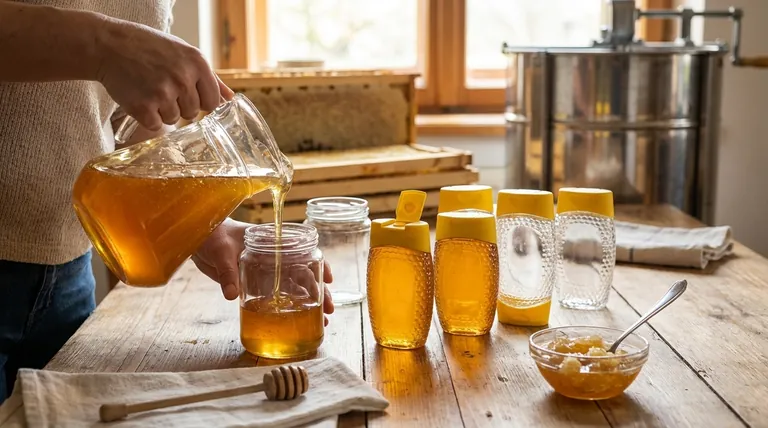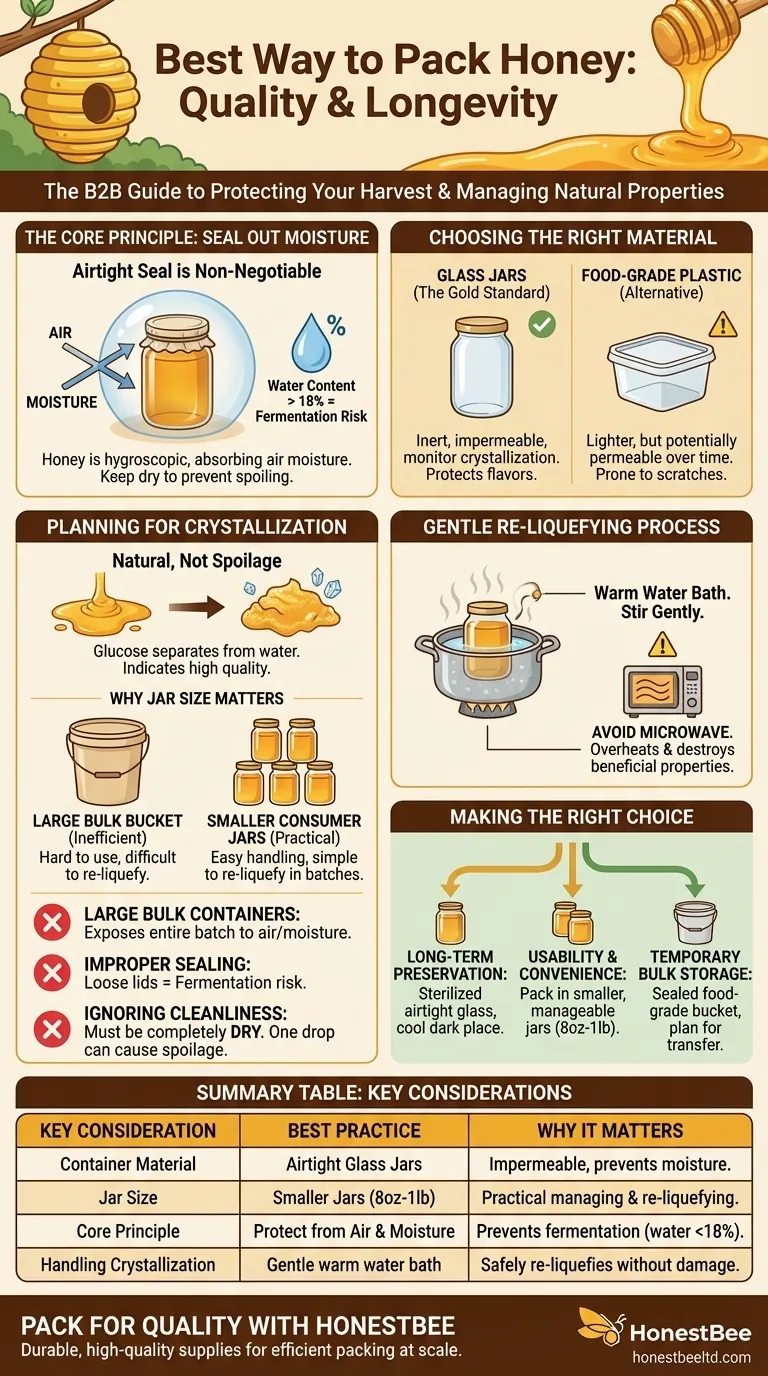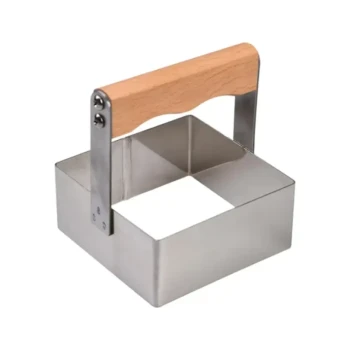The best way to pack honey is in clean, completely dry, airtight glass jars as soon as possible after extraction. This method is superior because it provides the best defense against honey's two primary challenges: absorbing moisture from the air and its natural tendency to crystallize.
The core challenge in packing honey isn't just finding a container, but actively managing its natural properties. An effective packing strategy protects honey from environmental moisture to prevent spoilage while anticipating its inevitable crystallization to ensure it remains usable long-term.

The Core Principle: Protecting Honey from Its Environment
Honey is remarkably stable, but its quality depends entirely on isolating it from outside elements, primarily air and the moisture it carries.
Why an Airtight Seal is Non-Negotiable
Honey is hygroscopic, meaning it readily absorbs moisture directly from the atmosphere.
If honey's water content rises above approximately 18%, dormant yeasts naturally present in it can activate, leading to fermentation and spoiling the batch.
A truly airtight seal is the only way to guarantee the honey's moisture level remains stable and safe.
Choosing the Right Material
Glass jars are the gold standard for honey storage.
Glass is inert, so it won't react with the honey or impart any unwanted flavors. It's also impermeable, providing a perfect barrier against air and moisture, and its transparency allows you to monitor for crystallization.
Food-grade plastic is a lighter, less fragile alternative, but it can be more permeable to air over long periods and is prone to scratches that can harbor contaminants.
Planning for Crystallization: The Inevitable Transformation
It's critical to understand that crystallization is a natural process for raw honey, not a sign of spoilage. Your packing strategy must account for it from the beginning.
Crystallization is Natural, Not Spoilage
Crystallization occurs when the glucose in honey separates from the water, forming small crystals. This is a sign of high-quality, unprocessed honey.
The key is to pack honey in a way that makes this state easy to manage.
Why Jar Size Matters
Storing your entire harvest in one large bucket is a common mistake. While convenient initially, a five-gallon bucket of solid, crystallized honey is incredibly difficult to handle and use.
Packing honey in smaller, consumer-sized jars makes the process of re-liquefying simple and practical. You only need to warm the amount you intend to use.
The Gentle Process of Re-liquefying
To return crystallized honey to its liquid state, simply place the glass jar in a warm water bath (not boiling) and stir gently until the crystals dissolve.
This method preserves the delicate enzymes and aromas. Avoid using a microwave, as its intense, uneven heat can overheat the honey and destroy its beneficial properties.
Common Packing Pitfalls to Avoid
Mistakes in packing can quickly degrade a high-quality harvest. Being aware of these common errors is essential for preserving the integrity of your honey.
The Risk of Large Bulk Containers
As mentioned, relying solely on a large bucket makes managing crystallization impractical. Every time you open it, you also expose the entire batch to air and potential moisture contamination.
The Problem with Improper Sealing
Using containers with loose-fitting lids is the most common cause of fermentation. Even a small gap can allow enough moisture exchange over time to spoil the honey. Always use new lids with intact seals.
Ignoring Container Cleanliness
Your containers must be impeccably clean and, most importantly, completely dry. A single drop of water left in a jar can create a micro-environment at the surface with high enough moisture content to initiate fermentation.
Making the Right Choice for Your Goal
Your packing strategy can be tailored to how you plan to use or distribute your honey.
- If your primary focus is long-term preservation: Use sterilized, airtight glass jars and store them in a cool, dark, and dry location to slow the natural rate of crystallization.
- If your primary focus is usability and convenience: Pack in smaller, manageable jars (e.g., 8oz to 1lb) that are easy to handle and can be gently warmed one at a time as needed.
- If you must store in bulk temporarily: Use a sealed, food-grade bucket, but make a plan to transfer the honey into final jarring containers before it crystallizes fully.
By understanding honey's fundamental nature, you can ensure every jar you pack retains the quality and character of your harvest.
Summary Table:
| Key Consideration | Best Practice | Why It Matters |
|---|---|---|
| Container Material | Airtight Glass Jars | Impermeable barrier, inert, prevents moisture absorption. |
| Jar Size | Smaller, consumer-sized jars (e.g., 8oz-1lb) | Makes managing and re-liquefying crystallized honey practical. |
| Core Principle | Protect from Air & Moisture | Prevents fermentation by keeping water content below 18%. |
| Handling Crystallization | Gentle warm water bath | Safely re-liquefies honey without damaging its beneficial properties. |
Ensure your honey harvest is packed for maximum quality and longevity.
For commercial apiaries and distributors, the right packaging is the final, critical step in delivering a superior product. HONESTBEE supplies the durable, high-quality beekeeping supplies and equipment you need for efficient and effective honey packing at scale.
Contact our wholesale experts today to discuss packaging solutions tailored to your commercial operation.
Visual Guide

Related Products
- Inverted Squeezable Honey Jar with No Drip Flip Top Cap for Easy Pouring
- Plastic Honey Gate Spout with Wing Nut for Beekeeping Honey Bucket
- Electric Honey Press Machine for Squeezing Honey Comb Press Equipment
- 10L Stainless Steel Electric Honey Press Machine
- 6 Frame Manual Stainless Steel Honey Extractor Beekeeping Equipment
People Also Ask
- What are the benefits of using glass jars for honey packaging? Preserve Flavor & Elevate Your Brand
- Can honey go bad in the heat? Protect Your Honey's Quality and Flavor
- What causes honey to crystallize? A Guide to Natural, High-Quality Honey
- How should honey be stored and packaged? Preserve Flavor & Quality with Proper Containers
- How should honey bottles be prepared before pouring honey into them? The #1 Rule for Honey Longevity



















